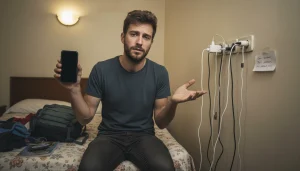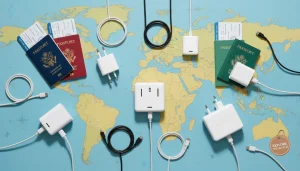
What is the best universal travel adapter for Trips? -Whenever I pack for a trip abroad, I have two recurring thoughts:
1. Did I overpack again?
2. Will my charger actually fit into the wall this time?
If you’ve ever stared helplessly at an unfamiliar socket in a hotel room, you already know how it feels. That’s why I never travel without a reliable universal travel adapter anymore. It’s the small hero that saves my gadgets—and my sanity—no matter where I land.
Over the years, I’ve tried more adapters than I can count (some survived, some sparked, literally). I’ve learned what makes one truly reliable, which models are worth your money, and what to avoid if you don’t want your devices fried halfway through your trip.
Here’s what you’ll learn in this guide:
- How do I pick the best adapter before flying
- My recommended adapters for 2025
- The difference between adapters and converters
- What features actually matter
- Mistakes I’ve made (so you don’t have to)
- My top choices for different types of travelers
- FAQs I get about international charging
Why a Universal Adapter Is a Must-Have
Let me be honest — I used to think “electricity is electricity.” I was wrong.
Sockets differ across countries. The prongs are different, the voltage varies, and sometimes even the shape looks like something from a sci-fi movie.
Once, in Italy, I spent two days staring at my dead phone because my regular charger refused to fit into the socket. Since then, my adapter has earned permanent residence in my backpack.
Having one device that connects your plug to any outlet is like having a universal translator for electricity — simple, small, and incredibly useful.
Before You Buy: What I Always Check
Choosing the right adapter isn’t just about price. I’ve learned to look for
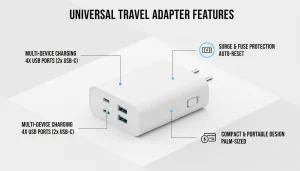
a few key things before I add one to my cart (or luggage).
1. Plug Compatibility
Different countries use different socket types — A, C, G, I, and more. A proper universal adapter covers all major plug styles, so you can hop from Europe to Asia without worrying.
For example, the UK uses Type G, Europe mostly Type C, and Australia Type I.
If you’re unsure, check my article on adapter types by country — it’ll make things easier before you pack.
2. Built-in USB Ports
Let’s face it, most of us travel with a small army of devices — phones, tablets, watches, maybe even a hair straightener. Having USB-A or USB-C ports on the adapter saves you from carrying multiple chargers. I prefer models with at least three ports — one USB-C for fast charging and two regular USBs for accessories.
3. Voltage Support
Here’s where many travelers (including me once) get it wrong.
Adapters only change the plug shape, not the voltage.
If you’re visiting a region with 220V power but your device only supports 110V, you’ll need a converter, not just an adapter. I’ve explained this in more detail in my post on universal travel adapter with a voltage converter.
4. Fuse Protection
Good models have built-in surge protection or replaceable fuses. Trust me, the last thing you want is a short-circuit in a hotel room in Bangkok.
5. Size and Portability
I prefer adapters that are compact but still sturdy. Some older models feel like carrying a brick. For frequent flyers, a lightweight adapter with retractable plugs makes a huge difference.
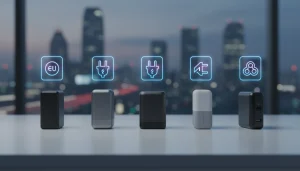
My Top Picks: Best Universal Travel Adapters (2025 Edition)
I’ve tested a bunch of adapters during my trips — from quick business visits to long vacations. Here are the ones that stood out this year.
1. EPICKA Universal Travel Adapter – Best Overall Pick
If I had to pick one adapter for all my trips, this would be it.
The EPICKA Universal Travel Adapter covers more than 150 countries and supports multiple plug types, including US, UK, EU, and AU.
Why I love it:
- Comes with 4 USB-A ports + 1 USB-C port
- Handles up to 880W at 110V or 1840W at 230V
- Built-in safety shutters and replaceable fuse
- Compact design fits easily in a carry-on
It’s my go-to option for international travel. I once used it to charge my phone, tablet, and camera — all at once — during a long layover in Singapore. It handled everything without a hiccup.
Best for: Frequent travelers who carry multiple devices.
2. OneWorld PD Pro – Best for Business Travelers
When I’m traveling for work, I can’t risk slow charging.
The OneWorld PD Pro is the fastest adapter I’ve used so far, thanks to its GaN technology and high wattage output (up to 75W).
What makes it special:
- Two USB-C ports with Power Delivery
- Dual USB-A ports for accessories
- Works in over 200 countries
- Sleek, professional design
I’ve charged my MacBook Air and phone simultaneously without overheating. For business trips, it’s the only one I pack.
Best for: Professionals who need to charge laptops or high-power devices.
3. TESSAN Universal Adapter – Best for Family Trips
Traveling with family means double the gadgets. The TESSAN adapter offers 5 charging ports and supports 4 devices at once.
Highlights:
- Dual USB-A ports + USB-C fast charging
- Supports over 150 countries
- Safety lock to prevent accidental plug-ins by kids
- Lightweight and easy to carry
I took this one on a two-week Europe tour with my family. It kept everyone’s devices charged — no arguments over outlets!
Best for: Families or group travelers.
4. MINGTONG Worldwide Adapter – Best Budget Option
If you’re traveling occasionally and don’t want to spend much, the MINGTONG adapter is a solid budget pick.
Features:
- Compatible with 150+ countries
- Dual USB-A ports
- Lightweight and small
- Safety shutters and a built-in fuse
It’s not the fastest or fanciest, but it does the job reliably. I keep one as a backup in my laptop bag.
Best for: Occasional travelers or budget-conscious buyers.
5. Zendure Passport III – Premium Choice
This one’s for the tech lovers. The Zendure Passport III is beautifully built and future-proof.
Why it’s worth it:
- GaN technology for superfast charging
- 4 USB-C ports + 1 USB-A
- Works in 200+ countries
- Smart auto-resetting fuse
- Up to 65W power output
It’s pricier, but the speed and design justify it. Plus, it supports newer gadgets that need higher wattage — like laptops and tablets.
Best for: Tech-heavy travelers who want the best of everything.
Comparison Table
| Adapter | Ports | Countries Supported | Wattage | Best For |
| EPICKA Universal | 4×USB-A, 1×USB-C | 150+ | 1840W | Everyday travelers |
| OneWorld PD Pro | 2×USB-C, 2×USB-A | 200+ | 75W | Business travel |
| TESSAN Adapter | 2×USB-A, 1×USB-C | 150+ | 2300W | Families |
| MINGTONG Adapter | 2×USB-A | 150+ | 2000W | Budget trips |
| Zendure Passport III | 4×USB-C, 1×USB-A | 200+ | 65W | Tech users |
Adapter vs. Converter – The Big Confusion
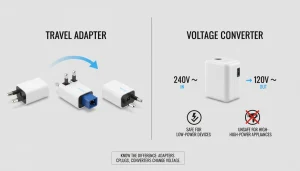
A lot of people mix up adapters and converters (I did too).
Here’s the difference, plain and simple:
- Adapter: Changes the plug shape so it fits into foreign sockets.
- Converter: Changes the voltage to protect devices that can’t handle different electrical outputs.
For instance, if your hairdryer only supports 110V and you plug it into a 230V outlet with just an adapter, it’ll burn out faster than your patience in a customs queue.
If you’re unsure which one you need, I’ve written a detailed post called Do I need an adapter or converter for Europe. It breaks down when you’ll need each type.
What Makes an Adapter Truly “Universal”?
A genuine universal adapter should:
- Cover at least 150 countries
- Have multiple plug sliders (for US, UK, EU, AU types)
- Include built-in USB charging
- Offer safety features like fuses or surge protection
- Be compact enough for travel
Some brands label theirs “universal” even if they only fit two regions. So always double-check before buying.
How I Pick the Right Adapter for Each Trip
Here’s my quick cheat sheet for choosing the right one:
- Weekend city trip: Small, lightweight adapter (like TESSAN).
- Business travel: High-output adapter with USB-C PD (OneWorld PD Pro).
- Long vacations: Durable and multi-device model (EPICKA or Zendure).
- Family trip: Multi-port, sturdy design (TESSAN).
When traveling to Europe, I usually double-check socket types using my Adapter Types by Country guide — it saves me from last-minute surprises.
Smart Safety Tips I Follow
- Always plug in the adapter first, then your device.
- Never force a plug into a socket if it doesn’t fit perfectly.
- Avoid cheap adapters with no fuse or certification marks.
- Keep your adapter away from water or moisture.
- Carry a spare fuse — tiny, but a lifesaver.
And yes, never leave your adapter plugged in overnight in a humid hotel room (learned that the hard way in Thailand).
Where a Good Adapter Saved My Day
- Tokyo Airport: My phone was down to 2%, and the EPICKA adapter powered it up before boarding.
- Paris Hotel: My partner’s hair straightener refused to work until we used the right plug converter.
- Dubai Conference: I ran a full presentation from my laptop using the OneWorld PD Pro — no overheating, no drama.
These little gadgets may look unassuming, but they’ve saved more trips than I can count.
Frequently Asked Questions
Q1: Can I use one adapter in every country?
Almost. A universal model covers most destinations, but a few places (like South Africa) have unique sockets, so check before you fly.
Q2: Do I need a voltage converter too?
Only if your device doesn’t support dual voltage. Many modern electronics (like laptops and phones) already do.
Q3: Is it safe to charge multiple devices at once?
Yes, as long as your adapter supports the combined wattage. Premium models handle this easily.
Q4: What’s better — USB-C or USB-A?
USB-C is faster and more efficient. If you travel often, choose an adapter with at least one USB-C PD port.
Q5: Can I carry my adapter on a plane?
Absolutely. Adapters are allowed in both carry-on and checked baggage. Converters or power banks, however, have separate rules — check my post on Do I need a voltage converter for Europe for flight-safe details.
Q6: Are all adapters safe for high-watt devices like hair dryers?
Not always. Unless the adapter has a built-in converter, it’s better to use dual-voltage appliances.
My Final Thoughts

Finding the right adapter isn’t glamorous, but it’s one of those tiny decisions that make travel smoother.
For me, EPICKA remains the best all-rounder — practical, durable, and travel-friendly. OneWorld PD Pro is unbeatable for work trips, and Zendure Passport III is pure luxury for gadget lovers.
Whichever you choose, just make sure it fits your travel habits and devices. Trust me — once you find your perfect plug partner, you’ll never again be that traveler begging reception for a spare charger.
If you’re still confused between plug types or voltage levels, check my other articles, like What is a universal travel adapter or Do I Need a Voltage Converter for Europe? . They’ll help you figure out what you really need before your next flight.
Because let’s be honest — in today’s world, a dead battery abroad feels more terrifying than lost luggage.
